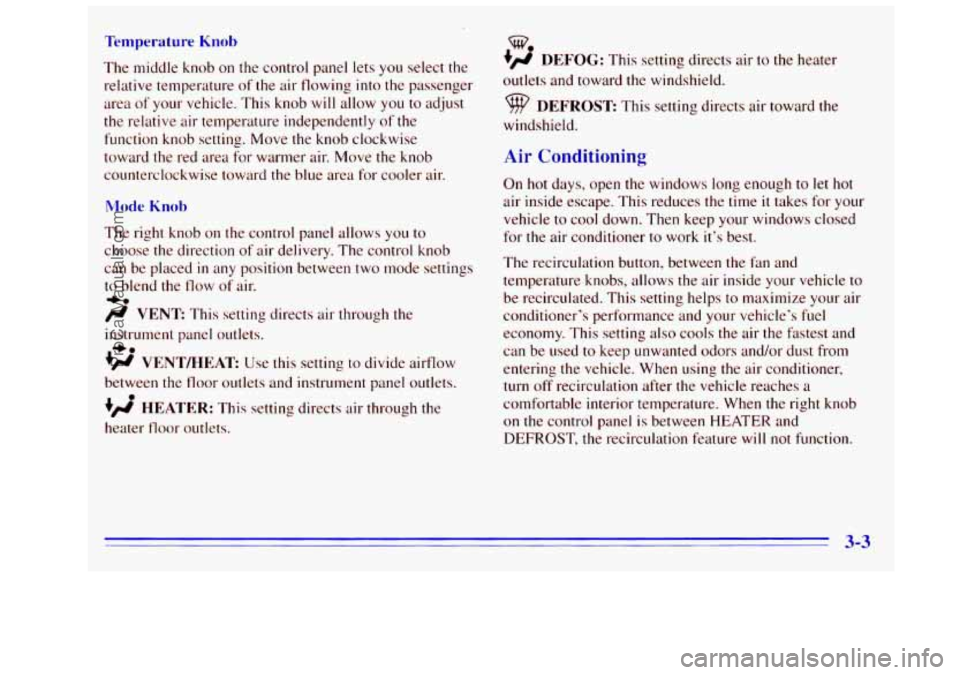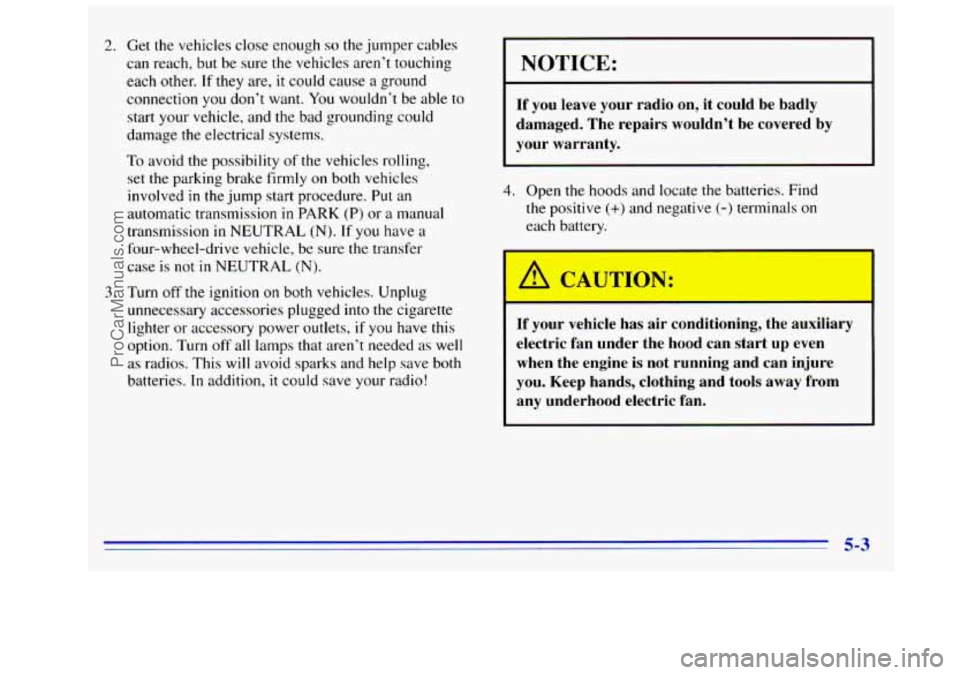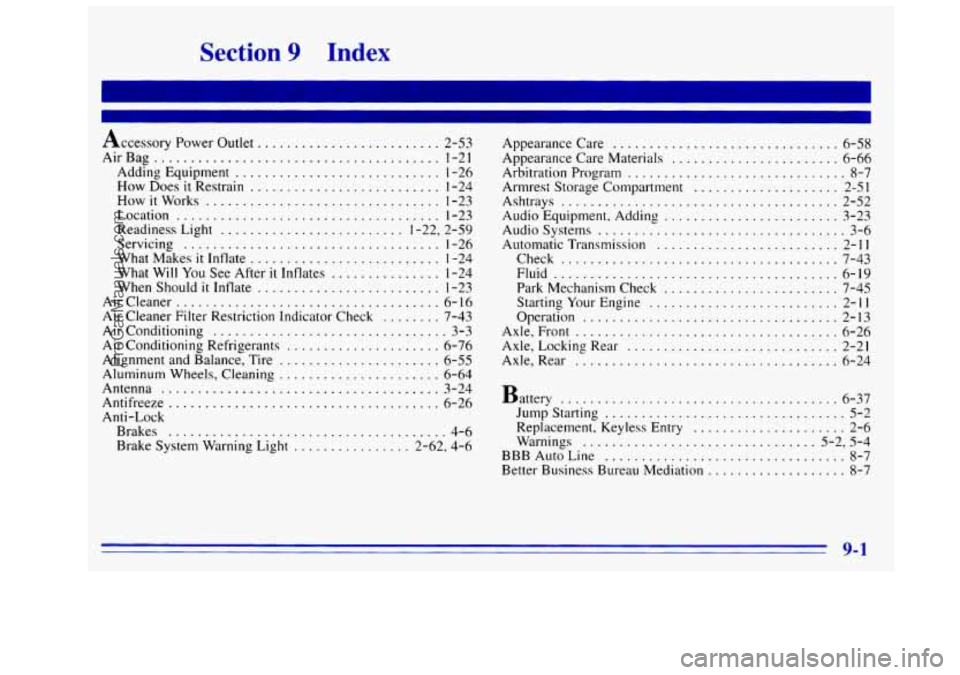1996 GMC SIERRA air conditioning
[x] Cancel search: air conditioningPage 133 of 404

Temperature Knob
The middle knob on the control panel lets you select the
relative temperature
of the air flowing into the passenger
area of your vehicle. This knob will allow you to adjust
the relative air temperature independently
of the
function knob setting. Move the knob clockwise
toward
the red area for warmer air. Move the knob
counterclockwise toward the blue area for cooler air.
The right knob on the control panel allows you to
choose the direction of air delivery. The control knob
can be placed
in any position between two mode settings
to blend the flow of air.
/J VENT: This setting directs air through the
instrument panel outlets.
+H VENT/HEAT Use this setting to divide airflow
between the floor outlets and instrument panel outlets.
+’ HEATER: This setting directs air through the
heater floor outlets.
+e
+.
0
Qe
+’ DEFOG: This setting directs air to the heater
outlets and toward
the windshield.
DEFROST This setting directs air toward the
windshield.
Air Conditioning
On hot days, open the windows long enough to let hot
air inside escape. This reduces the time it takes for your
vehicle
to cool down. Then keep your windows closed
for
the air conditioner to work it’s best.
The recirculation button, between the fan and
temperature knobs, allows the air inside your vehicle to
be recirculated. This setting helps
to maximize your air
conditioner’s performance and your vehicle’s fuel
economy. This setting also
cools the air the fastest and
can be used
to keep unwanted odors and/or dust from
entering the vehicle. When using the air conditioner,
turn off recirculation after the vehicle reaches a
comfortable interior temperature. When the right knob
on the control panel is between HEATER and
DEFROST, the recirculation feature will
not function.
ProCarManuals.com
Page 134 of 404

The A/C button, between the temperature and mode
knobs, allows
the air coming into your vehicle to be
cooled. This setting
is useful for normal cooling on hot
days. When
you use A/C with the recirculation button
pushed
in, turn off recirculation as soon as the vehicle
reaches a comfortable interior temperature.
With the
A/C on, move the temperature knob to MAX
for maximum cooling.
This setting also puts the system
in the recirculation mode and helps
to maximize your air
conditioner’s performance and your vehicle’s fuel
economy. This setting also cools the air the fastest. After
the vehicle’s interior reaches a comfortable temperature,
move the temperature knob clockwise to place the air
conditioning system
in the normal mode.
Heating
The heater works best if you keep your windows closed
while using
it. On cold days, use the HEATER or
VENT/HEAT setting with the temperature knob in the
red area.
If you use the engine coolant heater before starting your
engine (in cold weather (20°F (-8°C) or lower), your
heating system
will produce warmer air faster, to heat
the passenger compartment
in cold weather. The
use
of an engine coolant heater also reduces the
time
it takes for the engine to reach normal operating
temperature, and shortens the time
it takes the heater to
reach full output. For more information, see “Engine
Coolant Heater”
in the Index.
Ventilation System
For mild outside temperature when little heating or
cooling
is needed, use VENT to direct outside air
through
your vehicle. Air will flow through the
instrument panel outlets.
Your vehicle’s ventilation systeril supplies outside air
to the inside of your vehicle when it is moving. With
the side windows closed, air will flow into the front
air inlet grilles, through the vehicle, and out the air
exhaust valves.
Outside air will
also enter the vehicle when the heater or
the air conditioning fan is running, unless you have
the
recirculation button pushed in. For more information on
the recirculation button, see “Air Conditioning” earlier
in this section.
3-4
ProCarManuals.com
Page 219 of 404

2. Get the vehicles close enough so the jumper cables
can reach, but be sure the ve.hicles aren’t touching
each other.
If they are, it could cause a ground
connection you don’t want. You wouldn’t be able to
start
your vehicle, and the bad grounding could
damage the electrical systems.
To avoid the possibility
of the vehicles rolling,
set the parking brake firmly on both vehicles
involved
in the jump start procedure. Put an
automatic transmission
in PARK (P) or a manual
transmission
in NEUTRAL (N). If you have a
four-wheel-drive vehicle, be sure the transfer
case is not in NEUTRAL
(N).
3. Turn off the ignition on both vehicles. Unplug
unnecessary accessories plugged into the cigarette
lighter or accessory power outlets,
if you have this
option. Turn
off all lamps that aren’t needed as well
as radios. This will avoid sparks and help save both
batteries.
In addition, it could save your radio!
NOTICE:
I
~~~ ~
If you leave your radio on, it could be badly
damaged. The repairs wouldn’t be covered by
your warranty.
4. Open the hoods and locate the batteries. Find
the positive
(+) and negative (-) terminals 011
each battery.
A CAUTION:
If your vehicle has air conditioning, the auxiliary
electric fan under the hood can start up even
when the engine
is not running and can injure
you. Keep hands, clothing and tools
away from
any underhood electric fan.
5-3
ProCarManuals.com
Page 228 of 404

Cooling System -- Gasoline Engines
When you decide it's safe to lift the hood, here's what
you'll see:
A. Coolant Recovery Tdnk
B. Radiator Pressure Cap
C. Engine Fan(s)
A CAUTION:
If your vehicle has air conditioning, the auxiliary
electric fan under the hood can start up even when the engine is not running and can injure
you. Keep hands, clothing and tools away from
any underhood electric fan.
If the coolant inside the coolant recovery tank is boiling,
don't do anything else
until it cools down.
ProCarManuals.com
Page 256 of 404

Be careful not to spill gasoline. Clean gasoline from
painted surfxes as soon
as possible. See “Cleaning the
Outside
of Your Vehicle” in the Index.
When you put the cap back
on, turn it to the right until
you hear at least three clicks. Make sure you fully install
the cap. The diagnostic system can determine if the fuel
cap has been
left off or improperly installed. This would
allow
fuel to evaporate into the atmosphere. See
“Malfunction Indicator Lamp” in the Index.
I NOTICE:
If you need a new cap, be sure to get the right
type. Your dealer can get one for you. If you get
the wrong type, it may not fit or have proper
venting, and your fuel tank and emissions system
might be damaged.
Checking Things Under the Hood
h
I ! CAUTION:
If your vehicle has air conditioning, the auxiliary
engine fan under the hood can start up and
hjure you even when the engine
is not running.
Keep hands, clothing and tools away from any
underhood electric fan.
Things that burn can get on hot engine parts and
start a fire. These include liquids like gasoline or
diesel fuel, oil, coolant, brake fluid, windshield
washer and other fluids, and plastic or rubber.
You
or others could be burned. Be careful not to drop
or spill things that will burn onto a hot engine.
6-6
ProCarManuals.com
Page 322 of 404

Fuse
ECM-B
Usage
Fuel Pump, PCM/VCM
RR DEFOG Rear Window Defogger
IGN-E Auxiliary Fan Relay Coil, A/C
Compressor Relay, Hot Fuel Module,
Dual Tanks
FUEL SOL Fuel Solenoid (Diesel Engine)
Fuse
GLOW
PLUG
HORN
AUX FAN
ECM-
1
A/C
ENG-
1
Usage
Glow plugs (Diesel Engine)
Horn, Underhood Lamps Auxiliary Fan
Injectors, PCM/VCM
Air Conditioning
Ignition Switch, EGR, Canister Purge,
EVRV Idle Coast Solenoid, Heated
02,
Fuel Heater (Diesel Engine), Water
Sensor (Diesel Engine)
LIGHTING Headlamp and Panel Dimmer Switch,
Fog and Courtesy Fuses
Battery,
Fuse Block Busbar
BATT
IGN-A
IGN-B
ABS Ignition Switch
Ignition Switch
Anti-Lock Brake Module
BLOWER
Hi Blower Relay
STOP/HAZ Stoplamps
ProCarManuals.com
Page 326 of 404

J 28.5 quarts (27 L)
Fuel Tank Capacity (Approximate)
Type Quantity
Short Bed .................... .26 gallons (98 L)
Long Bed ................... .34 gallons (128 L)
Standard Crew Cab ........... 34 gallons (128 L)
Chassis-Cab Side Tank . .I ........ 23 gallons (87 L)
Chassis-Cab Rear Tank .......... 17 gallons (64 L)
3500 HD Models Side Tank ....... 23 gallons (87 L)
3500 HD Models Rear Tank ....... 18 to 20 gallons
(68 to.76
L)
-Air Conditioning Refrigerants
Not all air conditioning refrigerants are the same.
If the air conditioning system in your vehicle needs
refrigerant, be sure the proper refrigerant is used.
If you’re not sure, ask your
GM dealer.
See the refrigerant charge label under the hood for
information regarding refrigerant capacity.
ProCarManuals.com
Page 391 of 404

Section 9 Index
I
Accessory Power Outlet ......................... 2-53
AirBag
....................................... 1-21
Adding Equipment
............................ 1 -26
How Does it Restrain .......................... 1-24
How
it Works ................................ 1-23
Location
.................................... 1-23
Readiness Light
......................... 1-22, 2-59
Servicing ................................... 1-26
What Makes
it Inflate .......................... 1-24
What Will
You See After it Inflates ............... 1-24
When Should
it Inflate ......................... 1-23
Aircleaner
.................................... 6-16
Air Cleaner Filter Restriction Indicator Check
........ 7-43
Air Conditioning
................................ 3-3
Air Conditioning Refrigerants
..................... 6-76
Alignment and Balance, Tire
...................... 6-55
Aluminum Wheels, Cleaning
...................... 6-64
Antenna
...................................... 3-24
Antifreeze
..................................... 6-26
Anti-Lock
Brakes
...................................... 4-6
Brake System Warning Light
................ 2-62, 4-6
I
Appearance Care ............................... 6-58
Appearance Care Materials ....................... 6-66
Arbitration Program
.............................. 8-7
Armrest Storage Compartment
.................... 2-51
Ashtrays
...................................... 2-52
Audio Equipment. Adding
........................ 3-23
Audio Systems
.................................. 3-6
Automatic Transmission
......................... 2-11
Check
...................................... 7-43
Fluid
....................................... 6-19
Park Mechanism Check
........................ 7-45
Starting Your Engine
.......................... 2-11
Operation ................................... 2-13
Axle. Front .................................... 6-26
Axle. Locking Rear
............................. 2-21
Axle. Rear .................................... 6-24
Battery
...................................... 6-37
Jump Starting
................................. 5-2
Replacement. Keyless Entry
..................... 2-6
Warnings
................................ 5-2. 5-4
BBB Auto Line
................................. 8-7
Better Business Bureau Mediation ................... 8-7
9-1
ProCarManuals.com